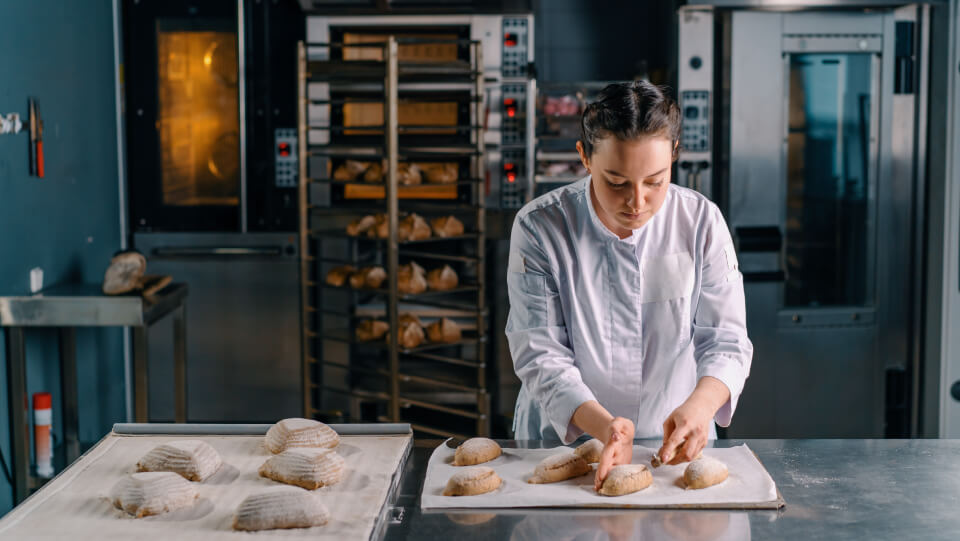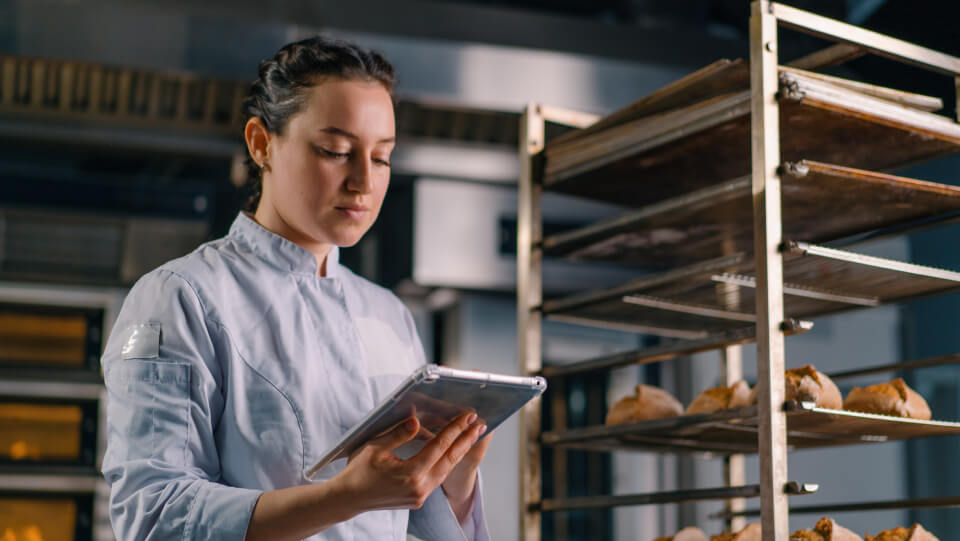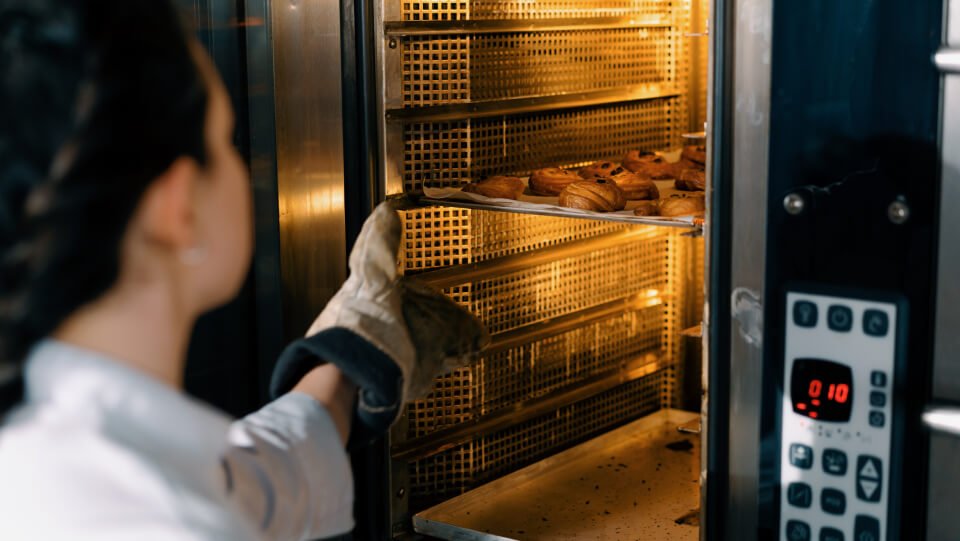In the culinary world, including the global expanse of food and beverage manufacturing, proof is literally in the pudding with consistency being the main ingredient. Ensuring that every product meets the same high standards across multiple production facilities is a challenge.
Standard Operating Procedures (SOPs) are the backbone of this effort, providing detailed instructions on how to prepare and package products.
Imagine a global chocolate manufacturer that prides itself on the silky smooth texture and rich flavor of its signature truffles. Traditionally, ensuring that every truffle meets the company's high standards would require meticulous text-based SOPs detailing every step, from tempering the chocolate to the precise folding technique for the ganache. However, slight variations in interpretation could result in inconsistencies, with some batches being too soft and others too firm.
The reality is that traditional text-based SOPs often fall short in capturing the nuances of manufacturing techniques and can be misinterpreted by staff with varying levels of experience and language proficiency. This is where multimodal SOPs, like DeepHow Maven, come into play, improving how food and beverage manufacturing processes are standardized and executed consistently across locations.
Consistency in recipe execution is crucial for maintaining brand integrity and customer satisfaction in the food and beverage manufacturing sector. The challenge of maintaining consistency is compounded when operations are spread across multiple locations. Consumers expect the same quality and taste whether they purchase a product made at one plant or another. Different facilities may have variations in equipment, local practices, and environmental conditions, making it difficult to ensure uniformity.
Variability in taste, texture, or packaging can lead to customer dissatisfaction and damage a brand's reputation. Moreover, consistency is not just about taste and presentation; it's also about efficiency and cost control. Inconsistent preparation methods can lead to wastage of raw materials, increased production costs, and regulatory compliance issues.
Establishing and maintaining uniformity in recipe execution is not just a culinary concern but a business imperative.
Human error, including lack of consistent standard operating procedures and poor training, is the main cause of food waste at the manufacturing level, accounting for more than 10 percent of total waste. Furthermore, incidents of food recalls due to non-compliance with safety standards can cost companies millions. For instance, the average cost of a food recall in the U.S. is estimated to be around $10 million, covering everything from lost sales to legal fees and brand damage.
Traditional SOPs, typically written documents with step-by-step instructions, have been the standard method for ensuring consistency. However, these SOPs come with significant limitations, especially for food and beverage manufacturers with multiple locations or global operations.


Text-based instructions can be open to interpretation, leading to variations in execution, particularly across different locations. Employees may understand and implement the same instructions differently.
In the case of dough mixing, a traditional SOP might instruct workers to "mix until the dough is smooth and elastic," but this leaves room for subjective interpretation. One worker might mix for a shorter time, considering the dough smooth enough, while another might mix longer, aiming for a different texture. This variability can result in inconsistent products, with some batches being over-mixed, leading to hard and crumbly bread, and others under-mixed, resulting in a flat, dense loaf.
Even when using automated equipment, SOPs might state to "mix at medium speed until dough is properly formed." However, without precise definitions of "medium speed" or "properly formed," different operators might choose different settings or durations, leading to inconsistent outcomes. The factors influencing dough formation, such as equipment speed, arm design, and temperature, are all critical but might not be adequately detailed in a traditional SOP, leading to further interpretation differences.
In a single facility, when instructions are unclear, operators can often ask a more experienced colleague or supervisor for clarification. However, in a global operation or when a manufacturer has multiple locations, this option is not always feasible. Workers at different facilities might not have immediate access to someone with the same level of experience or understanding of the instructions, leading to even greater inconsistencies in execution.

In a multicultural and multilingual workforce, or with global operations, language barriers can impede the understanding of SOPs, leading to errors and inconsistencies. A standard SOP written in English might be misunderstood by non-native speakers at different locations, resulting in mistakes during production.
A traditional SOP might instruct workers to "ferment the dough until it reaches peak readiness, indicated by a light, airy structure and slight acidity." For an English-speaking worker with a strong grasp of the language, these instructions might be straightforward. They understand the nuances of terms like "peak readiness" and can apply this knowledge effectively.
However, a non-native English speaker might have difficulty interpreting these instructions. The phrase "peak readiness" could be unclear, especially if they are unfamiliar with the subtle differences between stages of fermentation. Without a clear understanding, they might ferment the dough for too long, resulting in overly sour or overdeveloped dough that negatively impacts the bread’s flavor and texture. Alternatively, they might cut the fermentation short, leading to underdeveloped dough that produces a dense, flavorless loaf.
Language barriers can also cause confusion with specific technical terms or instructions that are common in English but challenging to translate. For instance, terms like "knead until smooth and elastic" or "proof at room temperature" might be interpreted differently depending on the worker's language proficiency. A worker who misinterprets "elastic" as simply soft rather than stretchy might under-knead the dough, while a misunderstanding of "room temperature" could lead to proofing the dough in an environment that's too warm or too cold, both of which could ruin the final product.


Not all staff have the same level of technical skills and experience. What might be clear to a seasoned operator could be confusing to a new hire.
A traditional SOP might instruct staff to "knead the dough until it reaches the windowpane stage." For a seasoned operator with years of experience, this directive is clear—they know exactly how to recognize when the dough has developed enough gluten to stretch thinly without breaking, which is indicative of proper kneading. They can feel the texture, understand the right level of elasticity, and adjust the kneading process accordingly, ensuring the dough is perfectly prepared.
However, for a new hire who may not have encountered the term "windowpane stage" before or an employee in another country where the term is obscure, this instruction can be confusing. They might not recognize when the dough has reached the correct stage, leading them to either under-knead or over-knead it. Under-kneading might result in a dense loaf with poor structure, while over-kneading could cause the dough to become too tough, resulting in hard and dry bread. This inconsistency can be particularly problematic when trying to maintain uniform standards across different countries.

The lack of visual and auditory cues in traditional SOPs can exacerbate the challenges faced by workers, especially when local conditions vary. Sensory experiences—such as sight, sound, and touch—play a crucial role in correctly executing many manufacturing processes. When these cues are not incorporated into the SOPs, it can lead to misinterpretation and inconsistent product quality. Text alone cannot convey the sound of a specific machine running correctly, the appearance of a perfect product, or the feel of a mixture at the right consistency.
A traditional SOP might instruct workers to proof dough until it has "doubled in size." For a seasoned baker, this might be second nature; they can visually estimate when the dough has risen sufficiently, relying on years of experience to judge the right moment. They might also notice subtle auditory cues, like the gentle release of gas from the dough or the feel of the dough's surface tension, to confirm that the proofing is complete.
However, for a less experienced worker, determining when the dough has "doubled in size" can be challenging without visual references. What does "doubled" look like in a particular batch size or type of dough? Without a clear visual guide—such as before-and-after images or a marked container showing the target volume—this instruction is prone to misjudgment. The worker might end up over-proofing the dough, which would cause it to collapse during baking, leading to a dense, uneven loaf. Conversely, under-proofing might result in bread that doesn’t rise properly in the oven, yielding a smaller, denser product with a compromised texture.
Additionally, traditional SOPs might fail to incorporate auditory cues that indicate a machine is running correctly. For example, an experienced operator might know the sound of a mixer operating at optimal speed, where the motor hums steadily without straining. They can tell if something is wrong just by listening—whether the dough is too dry, too wet, or if the machine is struggling. However, a new operator, relying only on written instructions, might not pick up on these sounds and fail to adjust the process accordingly. The result could be a poorly mixed dough, affecting the final bread quality.
These limitations underscore the need for more robust and adaptable multimodal SOPs, especially in global operations where consistency across diverse locations is critical for maintaining product quality and safety.

For food and beverage manufacturers with multiple locations or global operations, the need for consistent execution across all facilities is paramount. Traditional text-based SOPs often fall short in delivering the clarity and precision required to maintain uniform standards. To address this challenge, many companies are turning to multimodal SOPs, which integrate visual, auditory, and text-based instructions, creating a richer and more comprehensive guide for employees across diverse locations.
These SOPs can include video tutorials, annotated images, and audio clips, providing a multidimensional approach to learning and executing tasks. This approach leverages the strengths of different media to create a more effective and engaging way to communicate procedures.
The adoption of multimodal SOPs brings several benefits to food and beverage manufacturers striving for consistency in recipe execution.
DeepHow Maven, for example, allows organizations to capture expert knowledge in video format, automatically transcribe and translate content, and integrate it with text and other media. This not only standardizes the training materials but also makes them accessible to a global workforce. By using AI to analyze and organize content, DeepHow ensures that the SOPs are not only accurate but also engaging and easy to follow.
Additionally, one of the challenges with any training material is ensuring that it is understood and applied correctly. AI quizzing, like DeepHow’s Smart AI Quizzing, can be an effective solution in this regard. Integrated with multimodal SOPs, such as DeepHow Maven, quizzes using AI can assess comprehension and provide feedback.

One of the significant advantages of multimodal SOPs is their ability to incorporate real-time updates and feedback, which is crucial for maintaining consistency in global operations. Traditional SOPs are often static documents that require formal revisions and re-distribution when changes are made. This process can be slow and inefficient, leading to outdated practices lingering in some facilities.
In contrast, multimodal SOPs can be dynamically updated. For instance, if a new technique or piece of equipment is introduced, videos and instructions can be quickly edited and re-uploaded, ensuring that all facilities are on the same page. This immediacy is especially important in food and beverage manufacturing, where even small changes in procedure can have significant impacts on product quality.
Moreover, feedback loops integrated into these SOPs allow operators to report issues or suggest improvements directly through the platform. This feedback can be instantly shared with the entire global network, ensuring that best practices are continually refined and disseminated. This capability not only fosters a culture of continuous improvement but also ensures that all locations benefit from innovations or problem-solving techniques developed in any single facility.
In addition to enhancing consistency, multimodal SOPs play a crucial role in ensuring compliance with regulatory standards, which is a significant concern in the food and beverage industry. Global manufacturers must navigate a complex web of regulations that vary by region, covering everything from food safety standards to packaging requirements.
Multimodal SOPs can be tailored to include specific compliance guidelines for each location. For example, video content can highlight critical control points that must be monitored to comply with local food safety regulations, while quizzes and interactive elements can be used to certify that employees understand and can apply these guidelines.
This approach reduces the risk of non-compliance, and also ensures that all employees, regardless of location, are aware of and adhere to the necessary standards.
Furthermore, in the unfortunate event of a recall, having multimodal SOPs in place can significantly mitigate the impact. These SOPs provide a clear, documented trail of procedures and training that can be invaluable in demonstrating due diligence to regulators. They also enable faster identification and correction of the issue across all locations, minimizing both the scale of the recall and the associated costs.
The adoption of multimodal SOPs, like DeepHow Maven, is not just a technological upgrade but a strategic investment in the consistency, quality, and efficiency of global food and beverage manufacturing operations. By addressing the limitations of traditional SOPs and leveraging the strengths of multimedia and interactivity, manufacturers can ensure that their products meet the highest standards, no matter where they are made.

Start capturing, structuring, and activating your expert
knowledge today with a 14-day unlimited free trial.